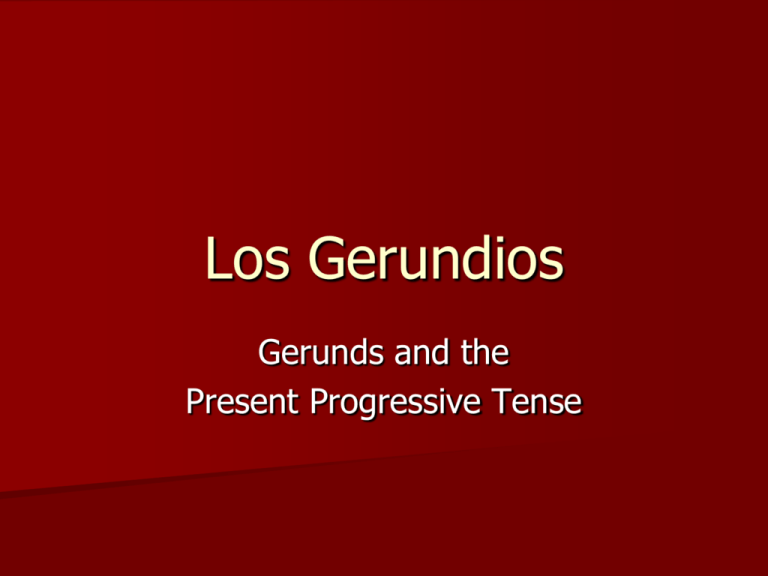gerunds.presprog
advertisement

Los Gerundios Gerunds and the Present Progressive Tense The Gerund form of a verb is not really a conjugation at all. There is not a different form for each person or point of view. In fact, there is only one gerund of each verb, just like there is in English. Gerundios … “-ing” verbs In English, we use the suffix “-ing” to indicate that an action is taking place now. Verbs ending in “-ing” are called gerunds. Running Crying Listening Talking Playing Laughing The Progressive Tense So, you will always use Estar with Gerunds. The construction looks like this: Subj. + [Estar + Conj.] + [Verb + Gerund] I am talking. Yo estoy hablando. Gerundios … “-ing” verbs Forming the Gerund in Spanish is almost as easy as it is in English. For –AR verbs such as habl ar Drop off the –ar ending And add -ando Gerundios … “-ing” verbs Forming the Gerund in Spanish is almost as easy as it is in English. For –AR verbs such as habl ando Drop off the –ar ending And add -ando So the gerundio of Tomar would be Tomando Caminar would be Caminando Bailar would be Bailando And Cantar would be Cantando Gerundios … “-ing” verbs For –ER and -IR verbs such as comer and viv ir Drop off the –er or -ir ending And add -iendo Beber would be Bebiendo Escribir would be Escribiendo And Asistir would be Asistiendo Gerundios … “-ing” verbs Bradley Cooper está corriendo Now let’s look at some examples of these verbs actually being used in real Spanish. Gerundios … “-ing” verbs I am talking. They are talking. We were talking. Charlie is talking. ¡Ojo! The verb talking never changes! What are the conjugated verbs in these sentences? That’s right… the verb “to be”. Remember that there are 2 verbs with mean “to be” in Spanish. When do you use each one? Ser vs Estar Estar Condition Location Progressive Ser Characteristic Origin/nationality/ religion/profession Time/Date (Basically…everything else.) The Progressive Tense This is the Progressive Tense! – – – – – I am talking. She is running. We are sitting. It is raining. It is snowing. All of these actions are going on right now… so we refer to them as Progressive: We emphasize the fact that they are progressing or going on right now. Yo estoy esquiando. I am skiing. Carlos está bebiendo jugo. Carlos is drinking juice. Nosotros estamos viviendo en Florida ahora. We are living in Florida now. ¿Cómo se dice…? Otros ejemplos in Español. 1. Andrés is playing the guitar. Andrés está tocando la guitarra. 2. Andrés and I are studying Spanish. Andrés y yo estamos estudiando español. 3. Andrea and María are playing tenis. Andrea y María están jugando al tenis. 4. Are you writing a letter? ¿Estás escribiendo una carta? 5. My friends are running along the beach. Mis amigos están corriendo por la playa. 6. It is raining. Está lloviendo. 7. It is snowing. Está nevando. 8. I am attending a Spanish class. Yo estoy asistiendo una clase de español. 9. Are you understanding? (entender/ comprender) ¿Estás entendiendo? ¿Estás comprendiendo? The Progressive Tense Remember that the Progressive Tense is used to EMPHASIZE the fact that the action is happening at this moment. In Spanish, you can still use the regular present tense to say that something happens or is happening now. Remember “llueve” and “está lloviendo”? – Both mean “It is raining”, but “está lloviendo” simply emphasizes the fact that it is taking place right now. The Progressive Tense ¿Qué significa…? Yo hablo. I talk. I am talking. Yo estoy hablando. I am talking (right now). Gerundios – Stem Changers A few gerunds have a stem change. **To form the present participle of -ir stem changing verbs, change o u and e i in the stem, and then add -iendo to the stem of the verb. pedir e i pidiendo dormir o u durmiendo Otros irregulares servir: sirviendo pedir: pidiendo decir: diciendo dormir: durmiendo morir: muriendo poder: pudiendo Sometimes when forming the present participle it is necessary to change the spelling of a word so that it agrees with the way it is pronounced. Here are some common examples: caer: cayendo creer: creyendo huir: huyendo (to flee) ir: yendo influir: influyendo oír: oyendo traer: trayendo leer: leyendo seguir: siguiendo Gerundios If a verb ends in (se), form the gerund regularly, then put the –se back on the end and put an accent over the –ándo or –iéndo. Gerundios maquillar(se) maquillándose cepillar(se) cepillándose lavar(se) lavándose






